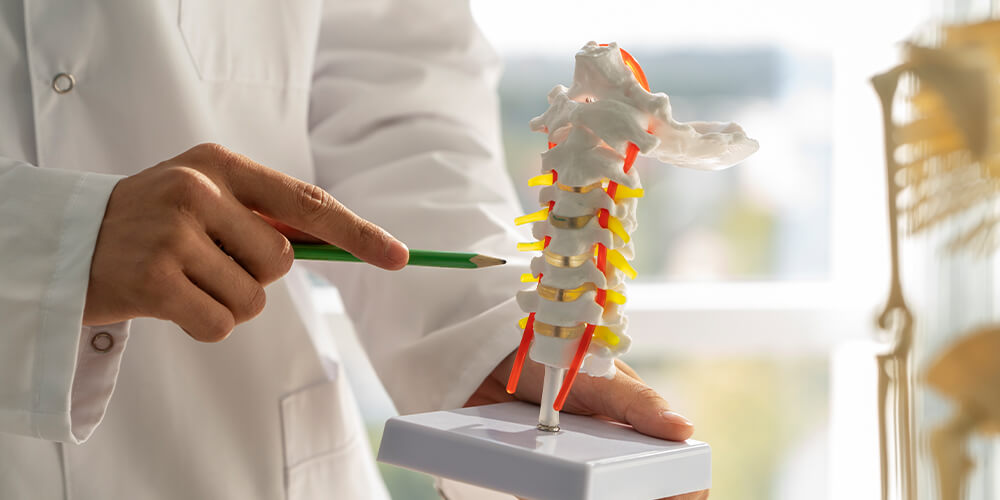Home » Treatment of Hernia and Spine Removal 2026

Surgery is often necessary for hernias that cause severe pain, increase in size, or are at risk for complications such as strangulation. There are two main surgical approaches:
In open hernioplasty, the surgeon makes an incision near the hernia site, repositions the protruding tissue and reinforces the weakened area with sutures or synthetic mesh. This method is effective and widely used, especially for large hernias.
A laminectomy involves removing the lamina, a part of the spinal bone, to create more space for the spinal cord and nerves. This procedure is often used to treat spinal stenosis and relieve nerve compression.
A discectomy is the removal of a herniated disc that is pressing on a nerve root or the spinal cord. This surgery can be done open or minimally invasive.
Spinal fusion surgery involves fusing two or more vertebrae together to stabilize the spine. This procedure is often used for severe degenerative disc disease or after a spinal tumor has been removed.
These minimally invasive procedures involve injecting bone cement into fractured vertebrae to stabilize the spine and reduce pain. Kyphoplasty includes the additional step of using a balloon to create space before injecting the cement.
Robot-assisted surgery has revolutionized the treatment of herniated discs and spinal removal. This technology provides surgeons with increased precision, flexibility, and control. Benefits of robotic-assisted surgery include:
Greater precision when performing complex procedures
Smaller incisions and reduced scarring
Shorter hospital stay
Faster recovery time
Advances in personalized medicine make it possible to develop individualized treatment plans based on a person’s genetics, lifestyle and health status. This approach leads to more effective and targeted treatment, minimizing risks and improving outcomes.
Advances in herniated disc treatment and spine removal are closely intertwined with technological innovations that have revolutionized surgical techniques and patient care. Laparoscopic and robotic surgeries, for example, offer precise, minimally invasive approaches that result in less pain, shorter hospital stays and faster recoveries than traditional open surgeries. These techniques utilize advanced imaging technology, robotics and instrumentation to improve surgical precision and patient outcomes. By adopting advanced technologies and continuously improving surgical approaches, healthcare providers can further optimize treatment strategies and improve overall patient outcomes.
In addition to surgical innovation, the introduction of Enhanced Recovery After Surgery (ERAS) protocols has been a game changer in the treatment of herniated discs and spinal removal. These multimodal perioperative treatment protocols incorporate evidence-based practices designed to minimize surgical stress, speed recovery, and reduce complications. Components of ERAS protocols may include preoperative optimization, individualized anesthesia techniques, early mobilization, and comprehensive pain management strategies. By adhering to ERAS principles, healthcare providers can standardize care, increase patient comfort, and promote a faster return to normal activities, ultimately improving long-term outcomes and patient satisfaction.
The era of personalized medicine promises to further improve herniated disc and spinal removal treatment outcomes. Using genetic, molecular, and clinical data, healthcare providers can customize treatment plans based on individual patient characteristics, preferences, and risk profiles. Precision medicine approaches can determine optimal surgical techniques, implant materials, and postoperative rehabilitation strategies based on each patient’s unique biological and clinical characteristics. In addition, genetic testing and biomarker analysis can help predict response to treatment and guide therapeutic decisions, paving the way for more targeted and effective interventions.
Effective treatment for spinal herniations and removals is based on a patient-centered approach that prioritizes individual needs, preferences and values. Health care providers should engage patients as active partners in the treatment process, fostering open communication, shared decision-making and informed consent. By providing comprehensive education, counseling, and support throughout the treatment process, patients can make informed choices, set realistic expectations, and actively participate in their recovery. In addition, initiatives such as patient advocacy groups and peer support networks enable individuals to navigate the health care system, advocate for their rights and access resources for optimal health and well-being.
In conclusion, advances in the treatment of herniated discs and spinal removal represent a major milestone in modern healthcare, offering patients more effective, less invasive and personalized treatment options. From technological innovations and surgical techniques to perioperative protocols and patient-centered approaches, the field continues to evolve, driven by a shared commitment to excellence, innovation and patient empowerment. By staying abreast of the latest treatment options, working closely with health care providers and advocating for personalized, comprehensive care, patients can achieve better outcomes and improved quality of life. Together, through collaboration, compassion and innovation, we can pave the way to a healthier and more resilient future for all.
Hello!